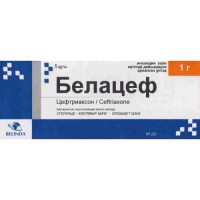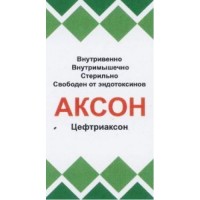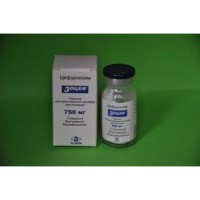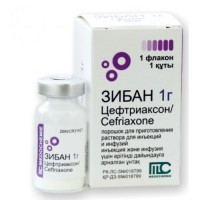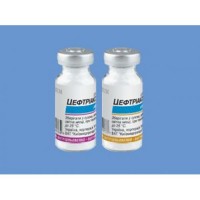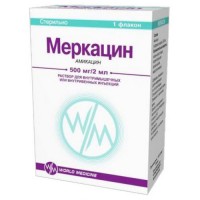Sertotsef 1's 1g powder for solution
- $14.80
The instruction for medical use of Sertotsef Torgovoye medicine a name Sertotsef Mezhdunarodnoye the unlicensed name Tseftriakson Lekarstvennaya a form Powder for preparation of solution for injections of 1.0 g complete with solvent (1% solution of lidocaine of a hydrochloride of 3.5 ml) Structure One bottle contains active agent – a tseftriakson of sodium of 1.193 g (it is equivalent to a tseftriakson of 1.0 g). Solvent active agent – lidocaine of a hydrochloride of 35.000 mg (in the form of lidocaine of a hydrochloride of monohydrate of 37.234 mg) excipients: 1 M sodium solution hydroxide to rn 5.0 – 7.0, water for injections up to 3.5 ml. The description Crystal powder, from white till yellow color, slightly hydroscopic. Solvent - Transparent, colourless solution. Pharmacotherapeutic gruppaantibakterialny drugs for system use. Beta laktamnye antibacterial drugs other. Cephalosporins of the third generation. Tseftriakson. ATX J01DD04 code. Pharmacological FarmakokinetikaTseftriakson properties reversibly contacts albumine. Linking with proteins of blood plasma – 85-95%. Thanks to lower content of albumine in interstitial liquid the concentration of a tseftriakson in it is higher, than in blood serum. Gets through a blood-brain barrier. At newborns and children at inflammation of a meninx, tseftriakson gets into cerebrospinal fluid, in case of bacterial meningitis of 17% of concentration of a tseftriakson in blood serum diffuses in cerebrospinal fluid. At adults in meningitis in 2-25 h after introduction of a tseftriakson in a dose of 50 mg/kg of body weight the concentration of a tseftriakson significantly exceeded the minimum inhibiting concentration for the most widespread causative agents of meningitis. Under the influence of intestinal microflora tseftriakson turns into an inactive metabolite. Elimination half-life makes about 5.8-8.7 h. At newborns (up to 8 days) and at elderly people 75 years are more senior average elimination half-life increases twice. At adult 50-60% of a tseftriakson 40-50% are removed in not changed view with urine, and - in not changed view with bile. At newborns about 70% of the entered dose it is removed by kidneys. In renal failures or a liver the elimination half-life is extended slightly. In renal failures the removal with bile kompensatorno increases, and in abnormal liver functions, removal of a tseftriakson kidneys amplifies. FarmakodinamikaDlitelno the operating tsefalosporinovy antibiotic of the III generation of a broad spectrum of activity for parenteral administration. The bactericidal activity of drug is caused by suppression of synthesis of a cell wall. Tseftriakson differs in big resistance to action of the majority beta laktamaz gram-negative and gram-positive microorganisms. It is active in the relation of the following microorganisms: Gram-positive aerobes: Staphylococcus aureus, Staphylococcus epidermidis, Streptococcus pneumoniae, Streptococcus pyogenes, Streptococcus agalactiae, Streptococcus viridans, Streptococcus bovis, Note. The strains of Staphylococcus spp. showing Methicillinum resistance, Enterococcus strains, many strains of Bacteroides spp. producing beta lactamelements are resistant to effect of drug. Gram-negative aerobes: Aeromonas spp., Alcaligenes spp., Branhamella catarrhalis (which are forming and not forming beta lactamelements), Citrobacter spp., Enterobacter spp. (some strains of a rezistentna), Escherichia coli, Haemophilus ducreyi, Haemophilus influenzae (including the strains forming penicillinase), Haemophilus parainfluenzae, Klebsiella spp. (including Klebsiella pneumoniae), Moraxella spp., Morganella morganii, Neisseria gonorrhoeae (including the strains forming penicillinase), Neisseria meningitidis, Plesiomonas shigelloides, Proteus mirabilis, Proteus vulgaris, Providentia spp., Salmonella spp. (including Salmonella typhi), Serratia spp. (including Serratia marcescens), Shigella spp., Vibrio spp. (including Vibrio cholerae), Yersinia spp. (including. Yersinia enterocolitica), separate strains of Pseudomonas aeruginosa are also sensitive to drug, Anaerobe bacterias: Bacteroides spp. (including some strains of Bacteroides fragilis), Clostridium spp. (except Cl.difficile), Fusobacterium spp. (except Fusobacterium mortiferum and Fusobacterium varium), Peptococcus spp., Peptostreptococcus spp. Note. Many strains of the beta lactamazoforming Bacteroides spp (in particular V. of fragilis) are steady. Also Cl.difficile is steady. Indications - sepsis - bacterial meningitis - infections of an abdominal cavity - an infection of bones, joints - the complicated infections of soft tissues, skins - infections against the background of a neutropenia - the complicated infections of urinary tract, including pyelonephritis - hospital and community-acquired pneumonia - acute average otitis - infections, sexually transmitted (including gonorrhea) - prevention of infections in the preoperative period the Route of administration and doses Solution it is necessary to use right after preparation. The prepared solution is stable within 24 hours at a temperature of 2 °C - 8 °C or within 6 hours at a temperature not above 25 °C. For an intravenous injection: 1 g of powder part in 10 ml of water for injections and enter intravenously slowly within 5 min. For an intramuscular injection: 1 g dissolve 1% of solution of lidocaine in 3.5 ml and enter deeply into rather big muscle (buttock). It is recommended to enter no more than 1 g into the same muscle. The solution containing lidocaine cannot be entered intravenously. Lidocaine is forbidden as solvent at children's and teenage age. Solutions of the drug Sertotsefa cannot be mixed or added to the solutions containing other antimicrobial drugs or other solvents because of possible incompatibility. To adults and children 12 years an average daily dose are more senior makes 1-2 g 1 times/days (in 24 h), in hard cases or in the infections caused by moderately sensitive bacteria, the daily dose can be increased up to 4 g. The newborn (to two-week age) - 20-50 mg/kg/days (the dose of 50 mg/kg of body weight is not allowed to be exceeded in connection with the unripe fermental system of newborns). To babies and children of younger age (from 15 days to 12 years) appoint 20-50 mg/kg of body weight of 1 times/days. In heavy infections - up to 80 mg/days. To children with the body weight of 50 kg and more appoint a dose for adults. Drug in a dose more than 50 mg/kg needs to be entered in the form of intravenous infusion, the drug should be administered within 30 min. Duration of therapy depends on a course of the disease. As well as always at antibiotic treatment, introduction of a tseftriakson should be continued the patient within at least 48-72 hours after normalization of temperature and confirmation of an eradikation of the activator. In bacterial meningitis to babies and children of younger age - an initial dose of 100 mg/kg of 1 times/days. After identification of the activator and determination of its sensitivity the dose can be reduced. The maximum daily dose - 4 g. Duration of therapy depends on the activator and can be 4 days for Neisseria meningitides, in the meningitis caused by Haemophilusm influenzae – 6 days, Streptococcus pneumoniae – 7 days. At treatment of gonorrhea the recommended dose makes 250 mg intramusculary once. For prevention of preoperative infections in 30-90 min. prior to operation the single introduction of Sertotsef in a dose of 1-2 g is recommended. At patients with renal failures on condition of normal function of a liver Sertotsef's dose is not reduced. At clearance of creatinine less than 10 ml/min. the daily dose should not exceed 2 g. At patients with abnormal liver functions on condition of normal function of kidneys Sertotsef's dose is not reduced. In a simultaneous abnormal liver function and kidneys and also at the patients who are on a hemodialysis it is regularly necessary to control concentration in blood serum. The dose of drug is not changed. Side effects Often: - liquid chair, diarrhea, nausea, vomiting Infrequently: - rash, itching, dermatitis, urticaria, hypostases, polymorphic exudative erythema Seldom: - stomatitis, a glossitis - increase in activity of transaminases, alkaline phosphatase - precipitation of calcic salts in a gall bladder - an eosinophilia, a leukopenia, a neutropenia, a granulocytopenia, hemolytic anemia, thrombocytopenia, lengthening of a prothrombin time - a headache, dizziness - anaphylactoid and anaphylactic reactions - phlebitis, pain in the place of an intravenous injection. Intramuscular introduction without lidocaine is painful - superinfections, including mycoses of a genital tract - an oliguria, increase in creatinine of serum, a glucosuria, a hamaturia - fever, a fever Very seldom: - pseudomembranous colitis, generally caused Clostridium difficile, pancreatitis - an erythema, Stephens-Johnson's syndrome, a Lyell's disease (toxic epidermal necrolysis) - an agranulocytosis, disturbance of blood clotting - an anury, a renal failure - adjournment of tseftriakson-calcium in kidneys - positive test of Koombs Vzaimodeystviye with calcium ions Are described separate fatal cases of formation of precipitated calcium superphosphates in lungs and kidneys by results of an autopsy research at the newborns receiving tseftriakson and kaltsiysoderzhashchy solutions. At the same time one venous access was in some cases used, and formation of precipitated calcium superphosphates was observed directly in a system for intravenous administration. At least, one case from the death is also described, at various venous accesses and to various time of introduction of a tseftriakson and calcium - the containing solutions. At the same time by results of an autopsy research precipitated calcium superphosphates were not found in this newborn. Similar cases were observed only at newborns. It was reported about sporadic cases of an agranulocytosis (& lt, 500/ml), the most part from them was observed after 10 days of treatment and against the background of purpose of total doses more than 20 g. It was reported about sporadic cases of serious reactions (multiformny erythema, Stephens-Johnson's syndrome, a toxic epidermal necrolysis (Lyell's disease)). Very exceptional cases of pseudomembranous colitis are described (& lt, 0.01%) and in kidneys, mainly, at children 3 years which were receiving or high daily doses of drug (more than 80 mg/kg a day), or cumulative doses more than 10 g and also having accessory factors of risk (liquid consumption restriction, a bed rest, etc.) are more senior than disturbances of blood clotting and also formation of concrements. Formation of concrements in kidneys can proceed asymptomatically or clinically be shown, can lead to a renal failure. This undesirable phenomenon has reversible character and disappears after the therapy termination tseftriaksony. The intramuscular injection without use of lidocaine is painful. In rare instances at treatment tseftriaksony at patients false positive results of test of Koombs can be noted. As well as other antibiotics, Tseftriakson can yield false positive result of test on a galactosemia. False positive results can be received also when determining glucose in urine by not fermental methods therefore during therapy tseftriaksony the glucosuria if necessary needs to be determined only by a fermental method. Contraindications - hypersensitivity to drug or to any of drug components hypersensitivity to cephalosporins and penicillin hypersensitivity to solvent – lidocaine a hyperbilirubinemia at newborn and premature (tseftriakson can force out bilirubin from communication with seralbumin, increasing risk of developing bilirubinovy encephalopathy at such patients) premature newborns up to 41 weeks (week of pregnancy + weeks of life) the full-term newborns (≤28 days): which already appoints or supposes intravenous treatment kaltsiysoderzhashchy solutions, including long kaltsiysoderzhashchy infusions, for example, at parenteral nutrition, because of risk of formation of precipitated calcium superphosphates of calcic salts of a tseftriakson with jaundice, a hypoalbuminemia and acidosis as in these diseases the insufficiency of binding of bilirubin I a pregnancy trimester the solutions containing lidocaine is probable it is forbidden to enter intravenously lidocaine as solvent is contraindicated at children's and teenage age Medicinal interactions It is impossible to mix Sertotsef rolled into one or the syringe with other antibiotic. Tseftriakson and aminoglycosides show synergism concerning gram-negative bacteria (it is especially proved their joint use in heavy and life-threatening infections). Tseftriakson, suppressing indestinal flora, interferes with vitamin K synthesis. Therefore at simultaneous use with the drugs reducing aggregation of thrombocytes (NPVS, salicylates, Sulfinpyrazonum) the risk of developing bleedings increases. For the same reason at simultaneous use with anticoagulants strengthening of anticoagulating action is noted. At simultaneous use with loopback diuretics the risk of development of nephrotoxic action increases. The incompatibility Sertotsef should not be added to infusion solutions, calciferous, for example, Hartman and Ringer's solution. Tseftriakson is incompatible and should not mix up with amsakriny, Vancomycinum, flukonazoly and aminoglycosides. Influence on results of laboratory analyses In rare instances at treatment by Sertotsef at patients false positive results of test of Koombs can be noted. As well as other antibiotics, Sertotsef can yield false positive result of test on a galactosemia. False positive results can be received also when determining glucose in urine therefore during therapy by Sertotsef the glucosuria if necessary needs to be determined only by a fermental method. Special instructions In a simultaneous heavy renal and liver failure should be defined regularly concentration of drug in blood plasma. At the patients who are on a hemodialysis it is necessary to watch concentration of drug in blood plasma since at them the speed of its removal can decrease. At long-term treatment by drug it is necessary to control a pattern of peripheral blood regularly. In rare instances at ultrasonography of a gall bladder blackouts which disappear after drug withdrawal are noted. Even if this phenomenon is followed by pains in right hypochondrium, recommend only symptomatic treatment. As well as at use of other cephalosporins, anaphylactic reactions, including from the death, even in cases when the patient had no allergic reactions in the anamnesis were registered. As well as at use of other cephalosporins, at treatment by Sertotsef the development of autoimmune hemolytic anemia is possible. Cases of heavy hemolytic anemia at adults and children, including from the death are registered. At development in the patient who is on treatment tseftriaksony the anemia cannot exclude the diagnosis cephalosporin - the associated anemia and it is necessary to cancel treatment before clarification of the reason. As well as at use of the majority of other antibacterial drugs, at treatment tseftriaksony cases of development of the diarrhea caused by Clostridium difficile (C. difficile), various weight are registered: from slight diarrhea to colitis from the death. Treatment by antibacterial drugs suppresses normal microflora of a large intestine and provokes growth of C. difficile. In turn, C. difficile forms toxins A and B which are factors of pathogenesis of the diarrhea caused by C. difficile. S.'s strains of difficile which are hyper producing toxins are causative agents of infections with high risk of complications and mortality, owing to their possible resistance to antimicrobic therapy, treatment can demand colectomy. It is necessary to remember a possibility of development of the diarrhea caused by C. difficile at all patients with diarrhea after antibiotic treatment. Careful collecting the anamnesis since cases of developing of the diarrhea caused by C. difficile later after therapy are noted more than 2 months by antibiotics is necessary. At suspicion or confirmation of the diarrhea caused by C. difficile the cancellation of the current antibiotic treatment difficile which is not directed to S. perhaps will be required. According to clinical indications the corresponding treatment with input of the fluid and electrolytes, proteins, antibiotic treatment concerning S. difficile, surgical treatment has to be appointed. As well as at treatment by other antibacterial drugs, superinfections can develop. At the patients receiving tseftriakson exceptional cases of change
of a prothrombin time are described. Control of a prothrombin time can be required by patients with insufficiency of vitamin K (synthesis disturbance, disturbance of food) during therapy and prescribing of vitamin K (10 mg/week) at increase in a prothrombin time prior to the beginning of or during therapy. After use of a tseftriakson, usually in the doses exceeding standard recommended, at ultrasound examination of a gall bladder, shadows which mistakenly took for stones came to light. They represent precipitated calcium superphosphates of calcic salt of a tseftriakson which disappear after end or the termination of therapy by the drug Sertotsef. Similar changes seldom give any symptomatology, but also in such cases only the conservative treatment is recommended. If these phenomena are followed by clinical symptomatology, then the decision on drug withdrawal is left to the discretion of the attending physician. Despite availability of data on formation of intravascular precipitated calcium superphosphates only at newborns at use of a tseftriakson and kaltsiysoderzhashchy infusion solutions or any other kaltsiysoderzhashchy drugs, tseftriakson should not mix or appoint children and adult patients along with kaltsiysoderzhashchy infusion solutions, even using various venous accesses. At the patients receiving tseftriakson exceptional cases of the pancreatitis developing perhaps, owing to obstruction of bilious ways are described. Most of these patients had risk factors of stagnation in bilious ways, for example, earlier carried out therapy, a serious illness and completely parenteral nutrition already before. At the same time it is impossible to exclude a starting role, formed under the influence of a tseftriakson, precipitated calcium superphosphates in bilious ways in development of pancreatitis. Researches showed what like other cephalosporins tseftriakson can force out bilirubin from communication with seralbumin. Tseftriakson it is impossible to apply at newborns who have a risk of developing bilirubinovy encephalopathy. Tseftriakson should not be applied to treatment of sinusitis, pharyngitis and prostatitis in connection with insufficiency of the clinical data confirming these indications. Pregnancy and a lactation Adequate and strictly controlled researches of safety of a tseftriakson at pregnancy were not conducted. It is impossible to use drug in II and III trimesters of pregnancy if to it there are no absolute indications. Tseftriakson gets through a placental barrier. In need of use of drug in the period of a lactation it is necessary to stop breastfeeding for the period of treatment. In small concentration tseftriakson it is allocated with breast milk. There Is no feature of influence of medicine on ability to run the vehicle any data indicating Sertotsef's ability to influence somehow driving or other vehicle. PeredozirovkaSimptoma: strengthening of manifestations of side effects. Treatment: the hemodialysis and peritoneal dialysis will not reduce concentration of drug. There is no specific antidote. Treatment is symptomatic. The form of release and packing Drug place equivalent 1 g of a tseftriakson in the bottles from colourless glass which are hermetically corked by a stopper from butyl rubber, pressed out by an aluminum cap with a plastic cover. On 3.5 ml of solvent (1% of solution of lidocaine of a hydrochloride for injections) spill in the ampoules from neutral glass of I type which are hermetically soldered. On 1 bottle with drug and 1 ampoule with solvent together with the instruction for medical use in the state and Russian languages place in a pack from cardboard Storage conditions At a temperature not over 25 s. To store out of children's reach! A period of storage a powder Expiration date - 3 years. Not to use after the expiration date specified on packing. Prescription status According to the prescription of the doctor the Producer FarmaVizhn San. ve Tidzh. A.Sh, Turkey Owner of the registration certificate of Dr. Sertus Ilach Sanayi Ve Tidzharet Limited Shirketi, Turkey Address: 34212 Evren Makhallesi, Dzhami Yolu Dzhaddesi No. 50, Girish Kat, Gyuneshli, Bagdzhylar, Istanbul, Turkey the Name, the address and a contact information (phone, the fax, electronic mails) the organizations of the claim (offer) on quality of medicines accepting in the territory of the Republic of Kazakhstan from consumers and responsible for post-registration observation of safety of medicine. TROKA-S PHARMA LLP, Almaty, Suyunbaya Avenue 222-b ph. 8+7 727 251 99 35, +7 727 251 99 45 fax: 8+7 727 252 90 90 +7 701 786 33 98 (24-hour access)
to Develop
of a prothrombin time are described. Control of a prothrombin time can be required by patients with insufficiency of vitamin K (synthesis disturbance, disturbance of food) during therapy and prescribing of vitamin K (10 mg/week) at increase in a prothrombin time prior to the beginning of or during therapy. After use of a tseftriakson, usually in the doses exceeding standard recommended, at ultrasound examination of a gall bladder, shadows which mistakenly took for stones came to light. They represent precipitated calcium superphosphates of calcic salt of a tseftriakson which disappear after end or the termination of therapy by the drug Sertotsef. Similar changes seldom give any symptomatology, but also in such cases only the conservative treatment is recommended. If these phenomena are followed by clinical symptomatology, then the decision on drug withdrawal is left to the discretion of the attending physician. Despite availability of data on formation of intravascular precipitated calcium superphosphates only at newborns at use of a tseftriakson and kaltsiysoderzhashchy infusion solutions or any other kaltsiysoderzhashchy drugs, tseftriakson should not mix or appoint children and adult patients along with kaltsiysoderzhashchy infusion solutions, even using various venous accesses. At the patients receiving tseftriakson exceptional cases of the pancreatitis developing perhaps, owing to obstruction of bilious ways are described. Most of these patients had risk factors of stagnation in bilious ways, for example, earlier carried out therapy, a serious illness and completely parenteral nutrition already before. At the same time it is impossible to exclude a starting role, formed under the influence of a tseftriakson, precipitated calcium superphosphates in bilious ways in development of pancreatitis. Researches showed what like other cephalosporins tseftriakson can force out bilirubin from communication with seralbumin. Tseftriakson it is impossible to apply at newborns who have a risk of developing bilirubinovy encephalopathy. Tseftriakson should not be applied to treatment of sinusitis, pharyngitis and prostatitis in connection with insufficiency of the clinical data confirming these indications. Pregnancy and a lactation Adequate and strictly controlled researches of safety of a tseftriakson at pregnancy were not conducted. It is impossible to use drug in II and III trimesters of pregnancy if to it there are no absolute indications. Tseftriakson gets through a placental barrier. In need of use of drug in the period of a lactation it is necessary to stop breastfeeding for the period of treatment. In small concentration tseftriakson it is allocated with breast milk. There Is no feature of influence of medicine on ability to run the vehicle any data indicating Sertotsef's ability to influence somehow driving or other vehicle. PeredozirovkaSimptoma: strengthening of manifestations of side effects. Treatment: the hemodialysis and peritoneal dialysis will not reduce concentration of drug. There is no specific antidote. Treatment is symptomatic. The form of release and packing Drug place equivalent 1 g of a tseftriakson in the bottles from colourless glass which are hermetically corked by a stopper from butyl rubber, pressed out by an aluminum cap with a plastic cover. On 3.5 ml of solvent (1% of solution of lidocaine of a hydrochloride for injections) spill in the ampoules from neutral glass of I type which are hermetically soldered. On 1 bottle with drug and 1 ampoule with solvent together with the instruction for medical use in the state and Russian languages place in a pack from cardboard Storage conditions At a temperature not over 25 s. To store out of children's reach! A period of storage a powder Expiration date - 3 years. Not to use after the expiration date specified on packing. Prescription status According to the prescription of the doctor the Producer FarmaVizhn San. ve Tidzh. A.Sh, Turkey Owner of the registration certificate of Dr. Sertus Ilach Sanayi Ve Tidzharet Limited Shirketi, Turkey Address: 34212 Evren Makhallesi, Dzhami Yolu Dzhaddesi No. 50, Girish Kat, Gyuneshli, Bagdzhylar, Istanbul, Turkey the Name, the address and a contact information (phone, the fax, electronic mails) the organizations of the claim (offer) on quality of medicines accepting in the territory of the Republic of Kazakhstan from consumers and responsible for post-registration observation of safety of medicine. TROKA-S PHARMA LLP, Almaty, Suyunbaya Avenue 222-b ph. 8+7 727 251 99 35, +7 727 251 99 45 fax: 8+7 727 252 90 90 +7 701 786 33 98 (24-hour access)
to Develop

